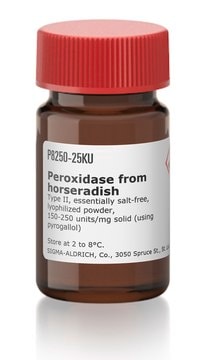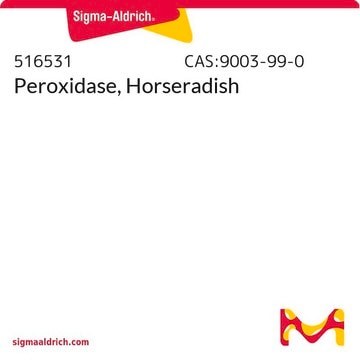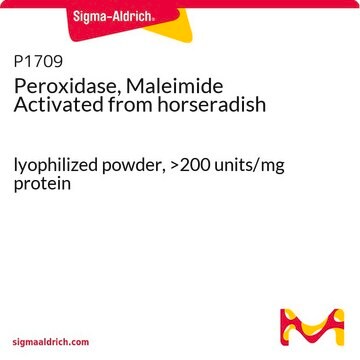P8375
Peroxidase from horseradish
Type VI, essentially salt-free, lyophilized powder, ≥250 units/mg solid (using pyrogallol)
Synonym(s):
Detection Enzyme, HRP, Peroxidase, Donor:hydrogen-peroxide oxidoreductase, Horseradish peroxidase
About This Item
Recommended Products
type
Type VI
form
essentially salt-free, lyophilized powder
specific activity
≥250 units/mg solid (using pyrogallol)
mol wt
~44 kDa
solubility
0.1 M phosphate buffer: soluble 10 mg/mL, clear, orange to red (pH 6.0)
absorbance ratio
RZ 2.5-4.0
application(s)
diagnostic assay manufacturing
storage temp.
2-8°C
InChI
1S/H2O3/c1-3-2/h1-2H
InChI key
JSPLKZUTYZBBKA-UHFFFAOYSA-N
Looking for similar products? Visit Product Comparison Guide
General description
Application
Biochem/physiol Actions
Unit Definition
Analysis Note
Other Notes
inhibitor
substrate
Signal Word
Danger
Hazard Statements
Precautionary Statements
Hazard Classifications
Resp. Sens. 1
Storage Class Code
11 - Combustible Solids
WGK
WGK 1
Personal Protective Equipment
Certificates of Analysis (COA)
Search for Certificates of Analysis (COA) by entering the products Lot/Batch Number. Lot and Batch Numbers can be found on a product’s label following the words ‘Lot’ or ‘Batch’.
Already Own This Product?
Find documentation for the products that you have recently purchased in the Document Library.
Customers Also Viewed
Articles
Discover our peroxidase from horseradish enzymes, products, substrates, and inhibitors for your ELISA, immunoassay, and protein application needs.
Protocols
Reinheitszahl (RZ) is the ratio of absorbance due to hemin (A403, Soret region) to absorbance due to protein (A275).
To standardize a procedure for the assay of Peroxidase using 2,2'-Azino-bis(3-Ethylbenzthiazoline-6-Sulfonic Acid) as a substrate.
This procedure is for the determination of Peroxidase enzymatic activity using Pyrogallol as the substrate.
Our team of scientists has experience in all areas of research including Life Science, Material Science, Chemical Synthesis, Chromatography, Analytical and many others.
Contact Technical Service











